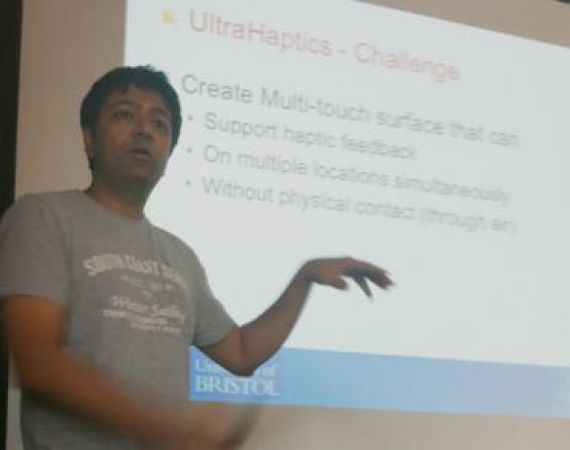Posted on Thu 17 May 2012
Lunchtime Talk: UltraHaptics
On Friday Sriram Subramanian gave a Lunchtime Talk on UltraHaptics. Sriram is part of the interaction and graphics group at the University of Bristol. The primary interest for the group's lab research is the collaboration between social scientists, artists, scientists and engineers. The key thing…

On Friday Sriram Subramanian gave a Lunchtime Talk on UltraHaptics. Sriram is part of the interaction and graphics group at the University of Bristol. The primary interest for the group's lab research is the collaboration between social scientists, artists, scientists and engineers. The key thing they are researching is the ability to couple device design with public use and evaluation, this means that the group's practice is heavily informed by user testing and actively invites learning through this method.
UltraHaptics is a development from multi-touch; having the ability to interact with a device with the touch of a fingertip, today's technology is increasingly offering the ability to zoom, pinch and grab on touch screens what Sriram questions is: "What can we do with this? How can we enhance this experience?"
So ‘touch technology' has now become part of our everyday lives but what use is touch without feeling? Sriram believes that the most important thing about being able to touch is to feel and so he poses: Can we create an UltraHaptic multi-touch surface? This would create Haptic feedback at every location of touch on a multi-touch screen.
Haptic feedback is the use of the sense of touch in a user interface designed to provide information to a user. When referring to mobile phones and similar devices, this generally means the use of vibrations from the device's vibration alarm to denote that a touchscreen button has been pressed. In this particular example, the phone would vibrate slightly in response to the user's activation of an on-screen control, making up for the lack of a normal tactile response that the user would experience when pressing a physical button. The resistive force that some "force feedback" joysticks and video game steering wheels provide is another form of haptic feedback.
There are different ways and devices that can be used to create haptic feedback:
Vibration Motors, commonly used in mobile devices, works by vibrating the whole device. For this to work you need to be holding the device and the vibrations are not multipoint, so not sensitive to location.
Phantom is the most popular haptic device at the moment, this is a single point device, with a stylus that you can hold, it produces haptic feedback that you can push and pull, creating a haptic force field.
Pin arrays is where you have push pins sticking up, that can contact the surface (your hand) in different locations, the number of pins is equal to the resolution of haptic system, for example 200 pins would provide 200 touch points, which may prove limiting.
Air Jets have nozzles though which airwaves are pushed out so you can feel haptic forces, the magnitude and direction of the applied force are controlled by changing the flow rate of the air jets and by activating different nozzles.
Electro- and magneto- rheological fluids are special fluids that can offer haptic sensation through electrical stimulation!
UltraHaptics is a multi-point mid-air haptic feedback system that uses sound as a pressure wave. If this is controlled in an inaudible frequency; ultrasound for example, sound waves can be focussed to provide pressure at different points, this process is called: acoustic radiation pressure. The interaction and graphics group conducted an experiment using this pressure. What they did was take an area of transducers in a 12x12 grid, to push ultrasound pressures through speakers this creates haptic feedback at three different points. The ultrasound transducers are triggered at different times so the pressure waves are focussed to concentrated areas.
Sriram and the interaction and graphics group have got lots of ideas around how to integrate UltraHaptics into our everyday lives in order to enhance our experiences, from moving physical objects to developing the way we watch television. Different experiments are taking place from day to day testing theories and making discoveries, to find out more about them visit: http://big.cs.bris.ac.uk/projects/ or www.youtube.com/BristolIG for a collection of related videos.
The University of Bristol and Pervasive Media Studio are joining forces to produce a workshop designed to better understand how creative practitioners and developers can work together in creating new and novel user experiences using a unique haptic system.
10 to 15 designers and developers working together in groups over two days in July. If you are interested in participating then please contact verity.alexander@watershed.co.uk or Sriram Subramanian.
Each group will have access to the haptic kit along with a couple of projectors, and cameras. Through a series of guided and open sessions the groups will design and create a haptic experience. There will be several breakout sessions where teams can work on their design. We are keen to learn more about the design process so we will be talking and videoing (without disturbing) how the groups interact with each other during the breakout sessions. The workshop will finish in a summative group session.